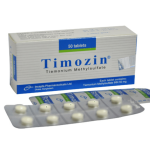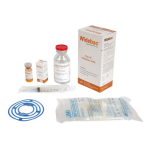Tigacil(Tigecycline)

Therapeutic Group: Anti Bacterial
Presentation
Tigacil: Each vial contains Tigecycline INN 50 mg as lyophilized powder.
Description
Tigecycline is a glycylcycline antibacterial agent for intravenous infusion. Tigecycline inhibits protein translation in bacteria by binding to the 30S ribosomal subunit and blocking entry of amino-acyl tRNA molecules into the A site of the ribosome. This prevents incorporation of amino acid residues into elongating peptide chains. To date there has been no cross-resistance observed between Tigecycline and other antibacterials. Tigecycline is not affected by the two major Tetracycline-resistance mechanisms- ribosomal protection and efflux. Additionally, Tigecycline is not affected by resistance mechanisms such as beta-lactamases (including extended spectrum beta-lactamases), target-site modifications, macrolide efflux pumps or enzyme target changes (e.g. gyrase/topoisomerases).
Indications
Tigecycline is indicated for the treatment of infections caused by susceptible strains of the designated microorganisms in the conditions listed below:
Complicated Skin and Skin structure Infections:
Complicated skin and skin structure infections caused by Escherichia coli, Enterococcus faecalis (vancomycin-susceptible isolates only), Staphylococcus aureus (methicillin-susceptible and -resistant isolates), Streptococcus agalactiae, Streptococcus anginosus grp. (includes S. anginosus, S. intermedius, and S. constellatus), Streptococcus pyogenes, Enterobacter cloacae, Klebsiella pneumoniae and Bacteroides fragilis.
Complicated Intra-Abdominal Infections:
Complicated intra-abdominal infections caused by Citrobacter freundii, Enterobacter cloacae, Escherichia coli, Klebsiella oxytoca, Klebsiella pneumoniae, Enterococcus faecalis (vancomycin-susceptible isolates only), Staphylococcus aureus (methicillin-susceptible and -resistant isolates), Streptococcus anginosus grp. (includes S. anginosus, S. intermedius, and S. constellatus), Bacteroides fragilis, Bacteroides thetaiotaomicron, Bacteroides uniformis, Bacteroides vulgatus, Clostridium perfringens, and Peptostreptococcus micros.
Community-Acquired Bacterial Pneumonia:
Community-acquired bacterial pneumonia caused by Streptococcus pneumoniae (penicillin-susceptible isolates), including cases with concurrent bacteremia, Haemophilus influenzae (beta-lactamase negative isolates), and Legionella pneumophila.
Dosage & Administration
The duration of therapy should be guided by the severity and site of the infection and the patient’s clinical and bacteriological progress. The recommended duration of treatment with Tigecycline for complicated skin and skin structure infections or for complicated intra-abdominal infections is 5 to 14 days and for community-acquired bacterial pneumonia is 7 to 14 days. The recommended daily dose is as follows:
Adults: The recommended dosage regimen for Tigecycline is an initial dose of 100 mg, followed by 50 mg every 12 hours. Intravenous (IV) infusions of Tigecycline should be administered over approximately 30 to 60 minutes every 12 hours.
Pediatric use: Safety and effectiveness in pediatric patients below the age of 18 years have not been established.
Geriatric use: No unexpected overall differences in safety or effectiveness were observed between these subjects and younger subjects.
Method of reconstitution
Each vial of Tigecycline should be reconstituted with 5.3 ml of 0.9% Sodium Chloride Injection to achieve a concentration of 10 mg/ml of Tigecycline. The vial should be gently swirled until the drug dissolves. Withdraw 5 ml of the reconstituted solution from the vial and add to a 100 ml intravenous bag of 0.9% Sodium Chloride or 5% Dextrose for infusion (for a 100 mg dose, reconstitute two vials; for a 50 mg dose, reconstitute one vial). The maximum concentration of IV solution should be 1 mg/ml. If the same intravenous line is used for sequential infusion of several drugs, the line should be flushed before and after infusion of Tigecycline with either 0.9% Sodium Chloride Injection or 5% Dextrose Injection.
Compatible Infusion fluid
Tigecycline is compatible with the following IV fluid:
0.9% Sodium Chloride Injection
5% Dextrose Injection
Lactated Ringer’s Injection.
Side Effects
The most common treatment-emergent adverse events are nausea and vomiting which generally occurre during the first 1-2 days of therapy. The following drug-related adverse events are reported infrequently in patients receiving Tigecycline:
Injection site inflammation & pain, septic shock, allergic reaction, chills, thrombophlebitis, bradycardia, tachycardia, vasodilatation, anorexia, dry mouth, hypoglycemia, hyponatremia, prolonged prothrombin time, eosinophilia, thrombocytopenia, vaginal moniliasis, vaginitis, leukorrhea.
Precautions
Tigecycline is structurally similar to Tetracycline-class antibiotics and should be administered with caution in patients with known hypersensitivity to Tetracycline-class antibiotics.
Pharmaceutical precaution: Prior to reconstitution, Tigecycline should be stored at 20°C to 25°C. Once reconstituted, Tigecycline may be stored at room temperature for up to 24 hours (up to 6 hours in the vial and the remaining time in the intravenous bag). Reconstituted solution may be stored refrigerated at 2 °C to 8 °C for up to 48 hours following immediate transfer of reconstituted solution into the intravenous bag.
Use in Pregnancy & Lactation
Pregnancy: Tigecycline should be used during pregnancy only if the potential benefit justifies the potential risk to the fetus.
Lactation: Caution should be exercised when Tigecycline is administered to a nursing woman.
Drug Interaction
Drug interaction of Tigecycline with Digoxin and Warfarin is observed.
Over Dose
No specific information is available on the treatment of overdosage with Tigecycline. Intravenous administration of Tigecycline at a single dose of 300 mg over 60 minutes in healthy volunteers resulted in an increased incidence of nausea and vomiting.
Commercial Pack
Tigacil : Each pack contains 1 vial containing Tigecycline INN 50 mg as lyophilized powder, 1 ampoule containing 0.9% Sodium Chloride BP 5.3 ml injection and one 5 ml sterile disposable syringe.



